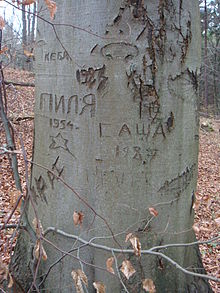bark
All tissues outside the central cylinder are referred to as the bark ( Latin cortex ) of the stem axis and the roots of vascular plants (tracheophyta) . When the term bark is used in everyday life, however, usually only part of the bark of woody plants is meant, namely the closing tissue, which is more specifically called periderm or bark .
construction
In plants without secondary growth or before its insertion, the bark comprises the base fabric between the epidermis and the central cylinder of the root or the cambium ring of the stem axis . The bark is usually rich in intercellular materials and is often used for storage. Often there are also strengthening tissue such as sclerenchymal and collenchymal strands in the cortex.
In plants with secondary growth in thickness, the bast (secondary phloem) released by the cambium is counted as part of the (secondary) bark. This consists of the sieve tubes with escort cells, bast fibers, and sclereids. Part of this bark forms the secondary closing tissue, the periderm . Colloquially, this periderm is called bark.
Plants with very strong secondary growth in thickness, many trees and bushes , form a tertiary final tissue, the bark , which is also commonly referred to as bark. In contrast to bark, injuries to the bark heal and remain visible for decades (see picture).
Come up
Bark is produced in all businesses that debark from logs . In Germany, around 4 million m³ of tree bark are produced every year when wood is used. 1–1.5 million m³ of this can be regarded as technically available. Worldwide, around 140–170 million m³ of bark are estimated each year (with ten percent bark share in wood use).
Usage properties and uses
Dried bark has good insulating properties and a higher fire resistance than wood. Due to their tannic acid content, they are relatively resistant to microorganisms.
Above all, the outer areas of the bark are used in many ways: their richness in tannic acid makes them important tanning materials. To obtain the tannins , the trees in question ( oaks and acacias ) are grown in deciduous forests . The saplings are only allowed to reach the age at which they produce the best bark. Many other rinds and beef parts, the cinchona bark or cinnamon are medicinally (see medicinal plant ) or as a spice used.
The cork oak and the Asian Amur cork tree provide the cork from which stoppers and corks are made. Bottle cork production accounts for around 70% of the added value in cork cultivation. Cork is also used in the manufacture of floor coverings and insulation materials and a number of other products.
Bark is mainly burned to generate energy and used as mulch bark ( bark mulch ); it is also processed into bark compost as a substitute for peat . Mulch bark and bark compost are produced by crushing, sieving and, if necessary, composting tree bark. They are delivered to the end user in bulk or in bags. Bark can also be mixed into energy pellets, but it reduces their quality. Like cork, bark from different tree species can also be used for various material applications. Appropriate approaches such as insulation boards, bulk insulation materials or decorative materials are currently still being developed.
literature
- W. Braune, A. Leman, H. Taubert: Plant anatomical practical course I. part; For an introduction to the anatomy of the vegetation organs of the seed plants. 6th edition, Gustav Fischer, Jena 1991, ISBN 978-3-334-60352-9 .
- Peter Schütt , Hans J. Schuck, Bernhard Stimm (Ed.): Lexicon of tree and shrub species. Special edition. Nikol, Hamburg 2002, ISBN 3-933203-53-8 .
- PH Raven, RF Evert, SE Eichhorn: Biology of plants. 3rd edition, R. Langenfeld-Heyser (transl.), Walter de Gruyter, Berlin / New York, 2000, ISBN 978-3-11-015462-7 .
- Andrea Kupferschmid: Bark knowledge and bark utilization. Holzkunde II Part 4, ETH Zurich, 2001, online (PDF; 7.41 MB), at www.research-collection.ethz.ch, accessed on February 9, 2017, doi: 10.3929 / ethz-a-004536640 .
Web links
Individual evidence
- ↑ Food and Agriculture Organization of the United Nations: FAO Yearbook of forest products, FAO statistics for 1999-2003. ISBN 978-92-5-005298-4 .
- ↑ a b Christian Warnecke: Material use of tree bark. Vdm Verlag Dr. Müller, 2008, ISBN 978-3-639-00237-9 , pp. 1-2.


